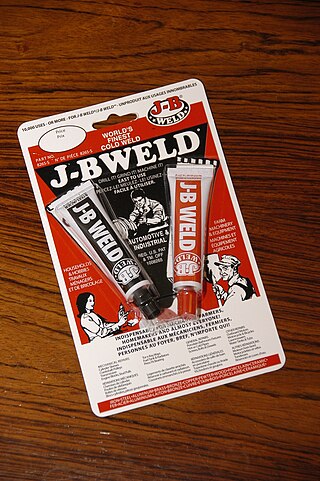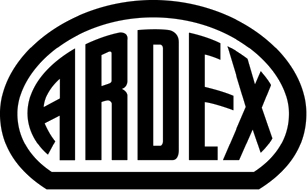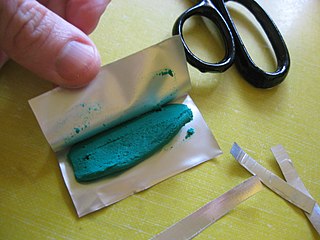Related Research Articles

Adhesive, also known as glue, cement, mucilage, or paste, is any non-metallic substance applied to one or both surfaces of two separate items that binds them together and resists their separation.

Blu Tack is a reusable putty-like pressure-sensitive adhesive produced by Bostik, commonly used to attach lightweight objects to walls, doors or other dry surfaces. Traditionally blue, it is also available in other colours. Generic versions of the product are also available from other manufacturers. The spelling now used is without a hyphen.

The Krugerrand is a South African coin, first minted on 3 July 1967 to help market South African gold and produced by Rand Refinery and the South African Mint. The name is a compound of Paul Kruger, the former President of the South African Republic, and rand, the South African unit of currency. On the reverse side of the Krugerrand is a pronking springbok, South Africa's national animal.

Cyanoacrylates are a family of strong fast-acting adhesives with industrial, medical, and household uses. They are derived from ethyl cyanoacrylate and related esters. The cyanoacrylate group in the monomer rapidly polymerizes in the presence of water to form long, strong chains.

Epoxy is the family of basic components or cured end products of epoxy resins. Epoxy resins, also known as polyepoxides, are a class of reactive prepolymers and polymers which contain epoxide groups. The epoxide functional group is also collectively called epoxy. The IUPAC name for an epoxide group is an oxirane.

In materials science, a thermosetting polymer, often called a thermoset, is a polymer that is obtained by irreversibly hardening ("curing") a soft solid or viscous liquid prepolymer (resin). Curing is induced by heat or suitable radiation and may be promoted by high pressure or mixing with a catalyst. Heat is not necessarily applied externally, and is often generated by the reaction of the resin with a curing agent. Curing results in chemical reactions that create extensive cross-linking between polymer chains to produce an infusible and insoluble polymer network.

Putty is a material with high plasticity, similar in texture to clay or dough, typically used in domestic construction and repair as a sealant or filler. Although some types of putty slowly polymerise and become stiff, many putties can be reworked indefinitely, in contrast to other types of filler which typically set solid relatively rapidly.

The J-B Weld Company is an international company that produces epoxy products. The home office is based in Sulphur Springs, Texas. J-B Weld is the name of their flagship product: a specialized, high-temperature epoxy adhesive for use in bonding materials together. The company has run advertisements showing engine block repair with J-B Weld.
Araldite is a registered trademark of Huntsman Advanced Materials referring to their range of engineering and structural epoxy, acrylic, and polyurethane adhesives. Swiss manufacturers originally launched Araldite DIY adhesive products in 1946. The first batches of Araldite epoxy resins, for which the brand is best known, were made in Duxford, England in 1950.
B-staging is a process that utilizes heat or UV light to remove the majority of solvent from an adhesive, thereby allowing a construction to be “staged”. In between adhesive application, assembly and curing, the product can be held for a period of time, without sacrificing performance.
Wood glue is an adhesive used to tightly bond pieces of wood together. Many substances have been used as glues. Traditionally animal proteins like casein from milk or collagen from animal hides and bones were boiled down to make early glues. They worked by solidifying as they dried. Later, glues were made from plant starches like flour or potato starch. When combined with water and heated, the starch gelatinizes and forms a sticky paste as it dries. Plant-based glues were common for books and paper products, though they can break down more easily over time compared to animal-based glues. Examples of modern wood glues include polyvinyl acetate (PVA) and epoxy resins. Some resins used in producing composite wood products may contain formaldehyde. As of 2021, “the wood panel industry uses almost 95% of synthetic petroleum-derived thermosetting adhesives, mainly based on urea, phenol, and melamine, among others”.
Loctite is an American brand of adhesives, sealants, surface treatments, and other industrial chemicals that include acrylic, anaerobic, cyanoacrylate, epoxy, hot melt, silicone, urethane, and UV/light curing technologies. Loctite products are sold globally and are used in a variety of industrial and hobbyist applications.
Sealant is a substance used to block the passage of fluids through openings in materials, a type of mechanical seal. In building construction sealant is sometimes synonymous with caulk and also serve the purposes of blocking dust, sound and heat transmission. Sealants may be weak or strong, flexible or rigid, permanent or temporary. Sealants are not adhesives but some have adhesive qualities and are called adhesive-sealants or structural sealants.

ARDEX GmbH is a manufacturer of special materials for the building trade with its global headquarters based in Witten, Germany. The company is operated as an independent family-owned business by Mark Eslamlooy, CEO ARDEX Group and CEO of ARDEX Germany. In 2018, the ARDEX Group, represented by 18 successful brands, made a turnover of €850 million with 3,300 staff.
LORD Corporation is a diversified technology and manufacturing company that develops adhesives, coatings, motion management devices, and sensing technologies for industries such as aerospace, automotive, oil and gas, and industrial. With world headquarters in Cary, North Carolina, LORD has approximately 3,100 employees in 26 countries and operates 19 manufacturing facilities and 10 R&D centers worldwide. As of October 30, 2019, the company has been acquired by Parker Hannifin.

Epoxy putty refers to a group of room-temperature-hardening substances used as space-filling adhesives. Exact compositions vary according to manufacturer and application. They are stored until used as two components of clay-like consistency. Kneading the two components into each other creates an exothermic chemical reaction that activates the substance for use by catalysing an epoxide polymerisation reaction. Unlike many other types of glues, an epoxy adhesive can fill gaps, and even be moulded into a structural part. Some makers claim in advertising that one can drill and tap their cured products and that they quickly cure "hard as steel", though they are much weaker than steel in tensile strength and shear strength.

Sugru, also known as Formerol, is a patented multi-purpose, non-slumping brand of adhesive silicone rubber that resembles modelling clay. It is available in several colours and upon exposure to air, cures to a rubber-like texture.

The Apollo 11 50th Anniversary commemorative coins were issued by the United States Mint in 2019 to commemorate the 50th anniversary of the first crewed landing on the Moon by Apollo 11 astronauts Neil Armstrong and Buzz Aldrin. Consisting of a gold half eagle, two different sizes of silver dollars, and a copper-nickel clad half dollar, each of the four was issued in proof condition, with all but the larger silver dollar also issued in uncirculated. The gold coins were struck at the West Point Mint, the silver at the Philadelphia Mint and the base metal half dollars at the mints in Denver and San Francisco.
Akemi GmbH is a company in the chemical industry which is active worldwide. Its headquarters are in Nuremberg in Germany and its core competence is the manufacturing of two-component adhesive systems. The chemical-technical specialist factory manufactures adhesives, fillers as well as cleaning and care products for the natural stone sector. In addition, it produces fillers and repair materials, sealants, protective coatings, varnishes as well as cleaning and car care products for the automotive branch.
References
- ↑ "Pratley Putty to feature in SA Mint commemorative coin series". BizCommunity. Retrieved 31 December 2019.
- 1 2 3 4 "PRATLEY ADHESIVES - HISTORY". pratleyadhesives.com.au. Retrieved 13 July 2016.
- ↑ "George Pratley – Pratley Putty designer & inventor extraordinaire – South African Tourism". southafrica.net. Retrieved 13 July 2016.
- ↑ "Moon landing: SA's sticky invention honoured for holding missions together". News24. 20 July 2019. Archived from the original on 20 July 2019. Retrieved 28 August 2019.